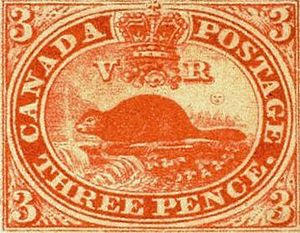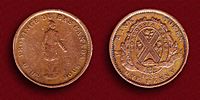Canadian pound facts for kids
Quick facts for kids Canadian pound |
||||
|---|---|---|---|---|
|
||||
| User(s) | Province of Canada | |||
| Subunit | ||||
| 1⁄20 | shilling | |||
| 1⁄240 | penny | |||
| 1⁄480 | sou | |||
| Symbol | £ | |||
| shilling | s or /– | |||
| penny | d | |||
| Plural | pounds | |||
| shilling | shillings | |||
| penny | pence | |||
| sou | sous | |||
The pound (symbol £) was the money used in what was then called the Canadas (today's Ontario and Quebec) until 1858. It was divided into smaller units: 20 shillings (s) made one pound, and each shilling had 12 pence (d). In Lower Canada, people also used a coin called the sou, which was worth half a penny. Even though this money system was similar to the British pound sterling, the Canadian pound was never worth exactly the same as the British pound.
Contents
History of the Canadian Pound
In early North America, there weren't many British coins around. So, people often used Spanish dollars instead. To make things easier, these Spanish dollars were given a value in the British pound system.
Different Ways to Value Money
Two main ways of valuing money became popular in the British colonies in North America.
- The Halifax rating was the most common. It said that one Spanish dollar was worth 5 shillings. This meant the Halifax pound was worth less than the actual British pound.
- The York rating was used in Upper Canada. It valued one Spanish dollar at eight shillings. This rating was officially stopped in 1796 but was still used unofficially for many years.
Trying to Use British Coins
In 1825, the British government tried to get their own coins used more in the colonies. They made British coins legal money, saying that one Spanish dollar was worth 4 shillings and 4 pence in British money. However, this value wasn't very realistic. It actually made the few British coins already circulating disappear, because people preferred to keep them or use them elsewhere.
New laws were planned in 1838 to fix this. But they weren't put into action in British North America because of recent uprisings in Upper and Lower Canada.
The New Canadian System of 1841
In 1841, the Province of Canada (which combined Upper and Lower Canada) started a new money system. This system was based on the older Halifax rating.
- One new Canadian pound was set to be worth 4 U.S. dollars.
- This also meant that one British pound sterling was worth £1 4 shillings and 4 pence in Canadian money.
- The first Canadian postage stamps even showed their value in this new Halifax system.
Debates Over Decimal Money
The 1850s were a time of big discussions about money. Should Canada keep the old pound, shilling, and pence system? Or should it switch to a decimal system, like the US dollar, which uses cents?
Many traders in Canada wanted to use a decimal system. This would make trading with the nearby United States much simpler. However, the British government in London wanted the British pound to be the main money everywhere in the British Empire.
In 1851, the Canadian parliament tried to introduce a system that mixed both ideas. They wanted to keep the pound, shilling, and pence but also add decimal coins. These decimal coins would match the value of US dollar coins. But the British government didn't approve this plan. They still hoped Canada would fully adopt the British pound system.
A strange compromise was suggested: a new system with "minims," "marks," and "royals." But this complicated idea was dropped.
Adopting the Gold Standard and the Canadian Dollar
In 1853, a new law brought the gold standard to Canada. This meant that the value of money was directly linked to a certain amount of gold. Under this law, British gold coins (sovereigns) and American gold coins (eagles) were made legal money.
- A British gold sovereign was worth £1 4 shillings and 4 pence in local Canadian money.
- An American gold eagle was worth $10 in local Canadian dollars.
This effectively created a Canadian dollar that was worth the same as the United States dollar. The Canadian pound was then worth about $4.86 in US dollars. No new Canadian coins were made at this time, but gold and silver coins from Britain and gold eagles from the US were legal to use.
The End of the Canadian Pound
In 1857, the Currency Act was changed. This law officially stopped using the pound system for keeping government accounts. It also ended the use of British sterling coins as legal money.
Instead, new decimal coins were introduced in 1858: 1¢, 5¢, 10¢, and 20¢. These coins were worth the same as US dollar coins. For the first time, Canadian postage stamps were also issued with decimal values in 1859. British gold sovereigns and other gold coins continued to be legal money.
Other Canadian Provinces and Their Money
- New Brunswick also switched to a decimal system linked to the US dollar in 1860.
- Nova Scotia also adopted a dollar in 1860. However, their dollar was set at $5 per gold sovereign, which was slightly different from Canada's value.
- Newfoundland introduced its own gold standard and decimal coins in 1865. Their dollar was based on the Spanish dollar, making it worth $4.80 per gold sovereign. This meant 2 Newfoundland cents equaled one penny. Newfoundland even minted its own gold two-dollar coin for a while. They switched to the Canadian money system in 1895 after a banking crisis.
- In 1867, the Province of Canada, New Brunswick, and Nova Scotia joined together to form the Dominion of Canada. Their different currencies were then combined into the single Canadian dollar.
- Prince Edward Island also went decimal in 1871, with a dollar linked to the US and Canadian dollars. They introduced 1-cent coins. However, Prince Edward Island joined Canada in 1873, and its money system was then absorbed into the Canadian system.
Coins of the Canadian Pound
Both Upper Canada (now southern Ontario) and Lower Canada (now southern Quebec) issued copper tokens.
- Between 1835 and 1852, banks like the Bank of Montreal and the Quebec Bank issued 1- and 2-sou tokens for use in Lower Canada. These were worth half a penny and one penny.
- The Bank of Upper Canada also issued half-penny and one-penny tokens between 1850 and 1857.
Banknotes of the Canadian Pound
Banks in Canada issued banknotes that showed values in both dollars and pounds/shillings. The exchange rate was £1 = $4, or $1 = 5 shillings. Many banks printed these notes, starting with the Bank of Montreal in 1817.
Some of the values on these notes included 5 shillings, 10 shillings, 15 shillings, £1, £1 and a quarter, £2 and a half, £5, £12 and a half, and £25. In 1837, some banks also issued smaller "scrip" notes. For example, the Quebec Bank issued notes for 6 pence (12 sous), a quarter dollar (30 sous or 1 shilling 3 pence), and half a dollar (60 sous or 2 shillings 6 pence).
See also
- Bank of Canada
- Sterling area
- List of countries by leading trade partners
- Lists of Commonwealth of Nations countries by GDP
- List of countries by leading trade partners
- Canadian banknote issuers




